COVER STORY

Part of Cornell's Law Library's world-class collection.
The library that never sleeps: 24/7 access, on campus and around the world
Several months ago, assistant professor of comparative literature Tom McEnaney heard whispers that the library was about to acquire a massive new punk archive.
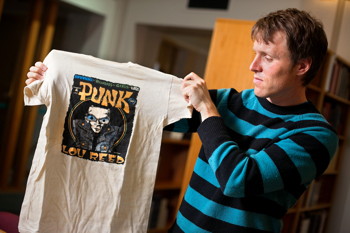
Tom McEnaney, assistant professor of comparative literature, examines a vintage T-shirt from Cornell University Library's punk archive. See larger image
The rumors were true: Cornell University Library received more than 3,000 items on English and American punk, the rock music-based subculture that originated in the 1970s, as a gift from Johan Kugelberg, a collector and Cornell parent. He carefully collected original manuscripts, fliers, posters, fanzines, sound recordings, clothing, photographs and original art for more than a decade. In March, the collection arrived in the Division of Rare and Manuscript Collections, which houses some of Cornell's greatest treasures in a climate-controlled vault two stories below the Arts Quad.
McEnaney was intrigued.
He knew that punk studies – "punkademia," as coined by a Boston Globe writer – was just entering the academy, and he is teaching a course this fall on the literature, art and music connected to punk. Throughout the semester, McEnaney will introduce students to the archive, and they will examine early works by Patti Smith, listen to recordings and look at vintage T-shirts and other artifacts.
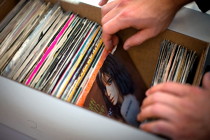
The punk collection, which was donated to the library in March, includes more than 3,000 recordings, photographs, fanzines, fliers and more. See larger image
"It will make the course unbelievably richer and give the students a real sense of the specific material culture around punk, but it will also give them a sense of how to do research. It'll be the sugar with their medicine," he jokes. "Hopefully, they will be drawn to the excitement and adventure of punk music, and along the way learn these important research skills."
Examples like this – anticipating teaching needs in emerging and established fields, and providing resources to support them – are key to the way Cornell's library functions, facilitating research, teaching and inquiry for the entire university.
A library legacy
Faculty and students at Cornell have long benefited from a progressive library system. In 1872, when the university's early library of 15,400 volumes moved to McGraw Hall, it became one of the first academic libraries in the country to serve undergraduates. In 1885, it became the first academic library to install electricity; lighting allowed it to stay open for more than 12 hours a day, longer than any other library in the country.
Andrew Dickson White, Cornell's co-founder and first president, built a great library with a focus on collections that allowed students to gain hands-on experience with primary sources. He preserved items relating to recent history, like abolitionist pamphlets and scrapbooks documenting the Civil War, which traditionally would not have been taught in university classes.
"Both A.D. White and Ezra Cornell knew that you taught through experience. It's not just books; it's not just ancient history," says University Archivist Elaine Engst. "They recognized the importance of documenting great events in your own time. Pamphlets and broadsides, things that were pasted up on walls … that's not typical.
"Their philosophy fits into our current punk and hip-hop collections. Once again, we have fliers that were tacked on walls or handed out on the street."
The idea that recent events are vital for teaching and learning is part of the library's enduring philosophy.
More virtual, more personal
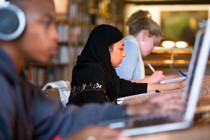
Students flock to the library's study spaces. Cornell's library buildings saw more than 4 million visits during the 2010-11 academic year; outside the library buildings, library.cornell.edu received about 10 million visits. See larger image
Today, a visit to a Cornell library, whether in person or online, provides a level of customization that would have been unthinkable half a century ago, when the massive card catalog ruled and students filled out carbon-copied punch cards to request items.
Digital access in particular has revolutionized research, expanding the role of bricks-and-mortar libraries into sources of constantly updated information. The library not only collects information, from scholarly journals to e-books to specialized databases, it facilitates its digital flow.
"Digital access doesn't threaten library services or spaces, it just gives us new avenues to reach users," says Anne Kenney, Cornell's Carl A. Kroch University Librarian. "In some areas, there may be less need for immediate physical access to books, and libraries are responding by consolidating print collections based on a fine-grained disciplinary approach that's specific to particular audiences and how they do research."
Digital services account for more than 60 percent of the library's $16 million annual expenditures for collections. Five million articles are downloaded from the library's digital subscriptions every year, so seamlessly that some people don't even realize they're accessing the library at all. The "virtual library" – its online presence – saw 10 million visits last year, up by more than 2 million just two years ago.
Constant evaluation
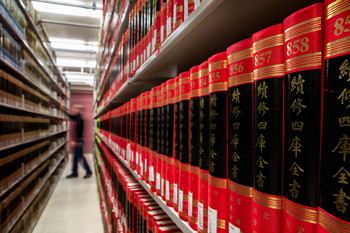
Kroch Library houses Cornell's massive Asia collection, one of the largest and most significant collections of Asian historical and literary materials in North America. Kroch Library has more than 30 miles of shelving and room for about 1.3 million volumes. See larger image
Those numbers might suggest that as digital access increases, people would find fewer reasons to go to a physical library building, but that's not the case at Cornell. The library's campus locations saw about 4.5 million visits during the 2010-11 academic year – close to a million more than five years ago. At nearly 8 million print volumes, the library's physical holdings are bigger than ever.
But challenges persist: Due to lean economic times and severely restricted budgets, total library expenditures have dropped by 6 percent in the last five years (adjusted for inflation).
"We need to constantly evaluate what we're doing and how well we meet the needs of our users, and tracking use patterns and trends carefully is the best way to do that," Kenney says.
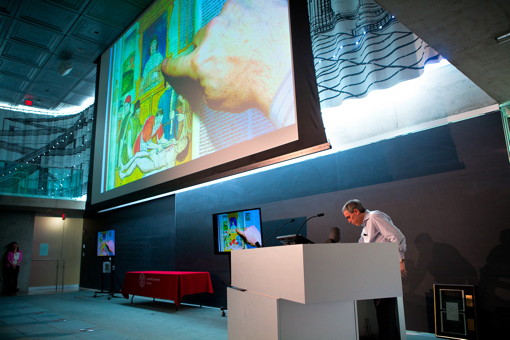
Jay Walker '77 shows an image of the first medical text during a Reunion lecture in Milstein Hall in June. The library is currently hosting the first public viewing of selections from Walker's private collection, which chronicles human imagination.
The library has consolidated several of its physical collections during the last few years. It is saving money on lesser-used circulation locations, like entomology, engineering and physical sciences, and books and periodicals from the hotel and management libraries have been combined into a single location at the ILR School.
Much of those savings fund the online resources that a 21st-century research environment demands and help retain expert librarians. These subject specialists help patrons in a variety of ways, online and in person, and stay close intellectually and physically to the departments they support.
The 'everywhere' librarian
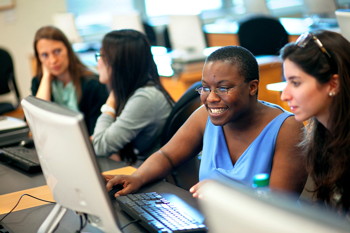
Camille Andrews, a learning technologies and assessment librarian who teaches information literacy, works with a student. See larger image
If a modern-day academic library is everywhere in the virtual world, librarians themselves are everywhere too – especially in the classroom, teaching students and taking collaborative roles with faculty members.
Over the course of a typical Cornell academic year, more than 22,000 people (students, researchers, faculty and others) participate in a presentation led by a library staff member.
These presentations take on a variety of formats, from one-off, drop-in workshops and library tours to semesterlong, for-credit courses like the Hotel School's "Information Survival Skills" or the Law library's courses jointly taught by a librarian and a professor. Last fall, Olin Library hosted an immersion program for Ph.D. students in the humanities that helped students transition from students to scholars.
That program and many others address information literacy, or the ability to find, evaluate and effectively use information from reliable sources. Helping to increase that skill is one of the library's primary goals, and it was recently included among seven essential learning outcomes as part of Cornell's assessment of student learning.
"There's a really common perception that you can just Google something and find perfectly reliable information," says Camille Andrews, learning technologies and assessment librarian. "Most students entering Cornell haven't had any training in information literacy before. They've never been introduced to thinking about doing research for in-depth academic purposes." Information literacy is incorporated into curricula across the university, in regular classes and targeted workshops.
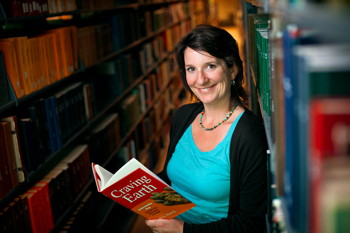
Sera Young, Ph.D. '08, research scientist in nutritional sciences, gave a "Chats in the Stacks" talk on her research. See larger image
"It's absolutely critical for not only a successful academic career, but also for just living in a democratic society," Andrews adds. "All the time, people make truth claims. If you can't think critically about how to evaluate information, you can't function in the modern world."
And the library itself is a central source of information: Cornell library staff members answer about 84,000 research and other substantive questions every year. They answer in person, at reference desks and on the phone, and via blogs, live online chats and text messages. In a survey of Cornell seniors this year, 87 percent said the library contributed to their ability to conduct research; 85 percent said that the library contributed to their academic success and efficiency. These numbers show a 2 percent to 5 percent uptick from 2010.
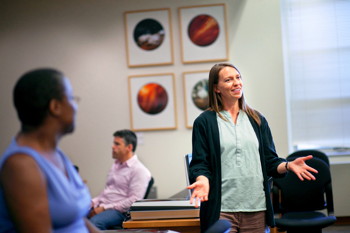
Life Sciences Librarian Sarah Wright leads a summer workshop for undergraduate biology students in Mann Library. See larger image
Library staffers also curate exhibitions, bringing historical and often valuable items to the public for free. The Rare and Manuscript Collections' current exhibition displays treasures from Jay Walker's library of the history of human imagination. At Mann Library, an online exhibition features photographs about the origins of limnology, or lake and freshwater studies.
"Beyond exhibition-worthy materials, the library simply collects research material for both the archives and for everyday use, ensuring that scholarship can continue," says Engst. "The library is preserving the historical record, whether it's rare and valuable materials or the most pedestrian ones."
Ambitious collaborations
The world of Cornell's library is quickly expanding beyond the confines of the campus. In 2009, Cornell and Columbia University libraries embarked on the first deep collaboration between two Ivy League libraries.
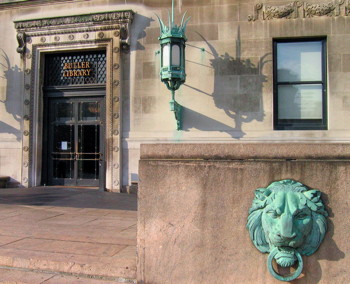
The Nicholas Murray Butler Library at Columbia University. See larger image
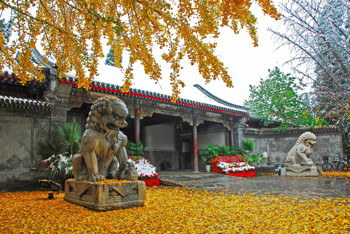
Tsinghua Garden at Tsinghua University in Beijing, China. See larger image
The partnership, which started with a grant from the Andrew W. Mellon Foundation, means that the library systems work together to coordinate collection development and share expert librarians and catalogers. Last summer, the libraries implemented a plan for joint borrowing – meaning that Cornell and Columbia students and faculty members can register for library cards, check out materials from both institutions' libraries, and enjoy expedited delivery to their own campuses.
"The premise is that owning the most stuff doesn't mean you've won the race of excellence," says Xin Li, associate university librarian for central library operations. "This agreement between Cornell and Columbia is really about sharing, about maximizing our strengths together to benefit the users. Thankfully, physical distance has been redefined by technology."
The first sharing of a subject librarian – for Russian, Eurasian and East European studies – between Cornell and Columbia won high praise in an anonymous satisfaction survey. One faculty member said that the "connection to the Columbia University research community is of great benefit to me due to the librarian's great understanding of scholarly needs at a comparable research university."
International collaborations are actively expanding to include projects in Africa and Asia. Li lived in Taiwan for the last two years, forging relationships with publishers and research libraries in Taiwan and China, including Tsinghua University in Beijing. Her efforts follow a decade of cooperation between the two universities, and she notes that collaborations across cultural and geographic boundaries not only strengthen the library, but also support Cornell's mission as a land-grant university.
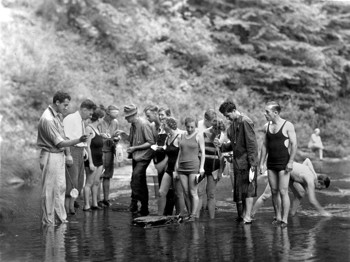
The library's Rare and Manuscript Collections includes this early 20th-century photo of Professor James Needham teaching the first limnology course in the United States. See larger image
"Higher education is more and more collaborative and less and less location-based," Li says. "We cannot just be local anymore, because our students and faculty could be in China or Qatar or Africa."
The library collaborates with faculty, too, working to help with their research and make it accessible to new and different audiences.
One local example is the "Chats in the Stacks" series, initiated more than a decade ago, which invites Cornell-based authors to give brief talks at libraries on campus.
Sera Young, a nutritional scientist at Cornell, recently gave a "Chats" talk on her latest book, "Craving Earth: Understanding Pica, the Urge to Eat Clay, Starch, Ice and Chalk." "My topic is really arcane and esoteric in some ways, but when you talk about pregnancy cravings, people can really relate to it," Young says. "'Chats in the Stacks' was a way for me to reach across all those boundaries and silos academia can set up. … The interdisciplinarity of Cornell blows me away, and the library is emblematic of just how connected this university is."
Anne Kenney puts it another way: "The library does so many different things, but each one of them is connected to a single goal: enhancing the life of the mind."
Keep in touch and be in the know
A Cornell degree has many benefits; one of them is continued access to valuable online Cornell University Library resources, including the recently added JSTOR, a popular database of scholarly journals. Alumni can also benefit from the expertise of Cornell librarians by asking them at alumni.library.cornell.edu.
Like the Library on Facebook, facebook.com/CornellUniversityLibrary, or follow it on Twitter, twitter.com/Cornell_Library.